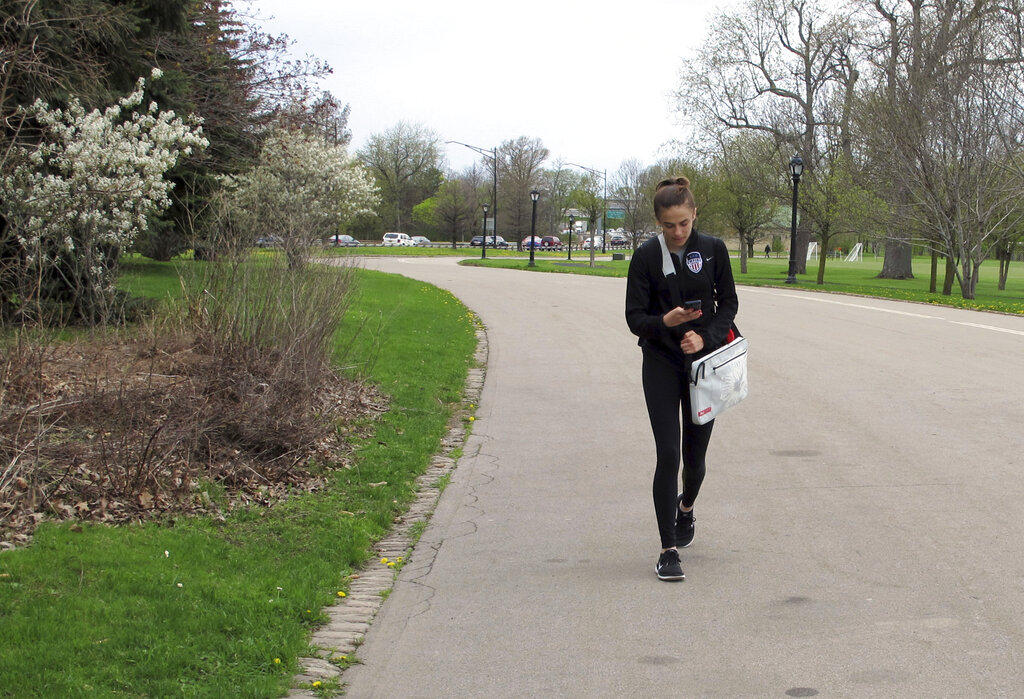
In this May 11, 2018 photo, Emily Mogavero, 17, looks at her cellphone while walking in Delaware Park in Buffalo, New York. The teenager said keeping up with social media and maintaining online profiles can make her stress levels rise but will put her phone out of reach or power it down to manage it. (AP)
BUFFALO, New York — High school biology teacher Kelly Chavis knew smartphones were a distraction in her class. But not even her students realized the psychological toll of their devices until an in-class experiment that, of course, was then spreading on social media.
For one class period, students used a whiteboard to tally every Snapchat, Instagram, text, call or other notification that popped up. Teachers around the country have run similar experiments, typically recording dozens of trips to the board.
“One girl, just during the one hour, got close to 150 Snapchat notifications. 150!” marveled Chavis, who teaches honors-level courses at Rock Hill Schools in South Carolina.
She’s among a growing number of teachers, parents, medical professionals and researchers convinced that smartphones are now playing a major role in accelerating student anxiety — a trend so pervasive that a National Education Association newsletter labelled anxiety a “mental health tsunami .”
Testing, extracurricular-packed schedules, and perpetual stressors like poverty can all weigh on students. But research now points to smartphone-driven social media as one of the biggest drivers of stress. After all, that’s where college acceptance letters fill Instagram, everyone knows where everyone else is going for spring break, and athletic failures and awkward social moments can live forever.
Jean Twenge, a psychology professor at San Diego State who has studied the issue, said it’s no coincidence that youth mental health issues have risen with the number of phones. “What a lot of teens told me is that social media and their phones feel mandatory,” she said.
Last year, an editorial in the American Academy of Pediatrics’ flagship journal recommended that doctors ask adolescent patients about their social media use as part of routine screening, alongside older questions about home life and drug and sexual activity. “Aberrant and/or excessive social media usage” could contribute to teenage “feelings of isolation, depressive symptoms, and anxiety,” three researchers wrote in the journal Pediatrics.
Researchers are still arguing whether phones drive student depression or depression drives phone use. But 70 percent of teens view anxiety and depression as major problems among their peers, according to a February Pew Research Center report. Nearly 60 percent of parents said they worry about the influence of social media on their child’s physical and mental health in the American Psychological Association’s 2017 Stress in America survey.
Schools are starting to react. Many districts now hire outside companies to monitor students’ social media postings for signs of distress. Others invite in yoga instructors and comfort dogs to teach even the youngest kids to keep technology from putting them on edge.
Belfast Area High School in Maine even staged an #unplugged event day in April — but it served to underline the technology’s pull when less than 20 percent of students and staff took part.
When she first got a smartphone around seventh grade, all the posting, messaging and liking pushed Nia Coates’ anxiety level to “probably a 10,” she said. Now a high school junior, the Buffalo, New York, teen has figured out to manage the distractions.
She’ll completely log out of her Snapchat, Instagram and Twitter, and sometimes will delete an app altogether for a while.
Anxiety has taken over as the most significant obstacle to learning among Chris Doyle’s high school students at Avon Old Farms School in Connecticut. Some rack up absences because they feel overwhelmed by the day ahead, Doyle said. A teacher for 30 years, he has seen a profound shift toward constant self-evaluation that he associates with social media, YouTube, and even school grade portals sometimes checked dozens of times a day — things students have never before had to manage.
Awareness of other people’s lives, even their private lives, is “kind of hyper right now,” Doyle said. “And I don’t think that usually leaves most people feeling good, because nobody’s perfect and most kids feel very imperfect.”
But putting the genie back in the bottle isn’t easy. In Illinois, Glenbrook High Schools District 225 experimented with limiting teens’ access to their grades on a digital portal. But for every student who said the grade book caused them anxiety, there was another who said losing regular access created even more stress, said instructional innovation director Ryan Bretag.
“I definitely feel stress with online profiles, social media, to keep up, maintain my profiles and stuff,” said Emily Mogavero, a 17-year-old student in Buffalo, New York. “It kind of worries me that I’m on my phone so much.” Mogavero said she sometimes puts her phone out of reach or powers it down so she doesn’t hear notifications.
Teaching limits at an earlier age might help. Deirdre Birmingham of Montclair, New Jersey, signed onto a campaign called “Wait Until Eighth ” because she didn’t think her video game-loving 10-year-old son was ready to manage a smartphone’s pull.
The idea, which got its start in Texas two years ago, is to lessen the peer pressure of being the only kid without a phone by enlisting parents of classmates to agree to hold off until at least eighth grade. So far, almost 20,000 people have signed on, founder Brooke Shannon said.
“I had a gut level that it would be difficult for my child to manage,” Birmingham said. “As a grown-up, I find it difficult sometimes to manage.”